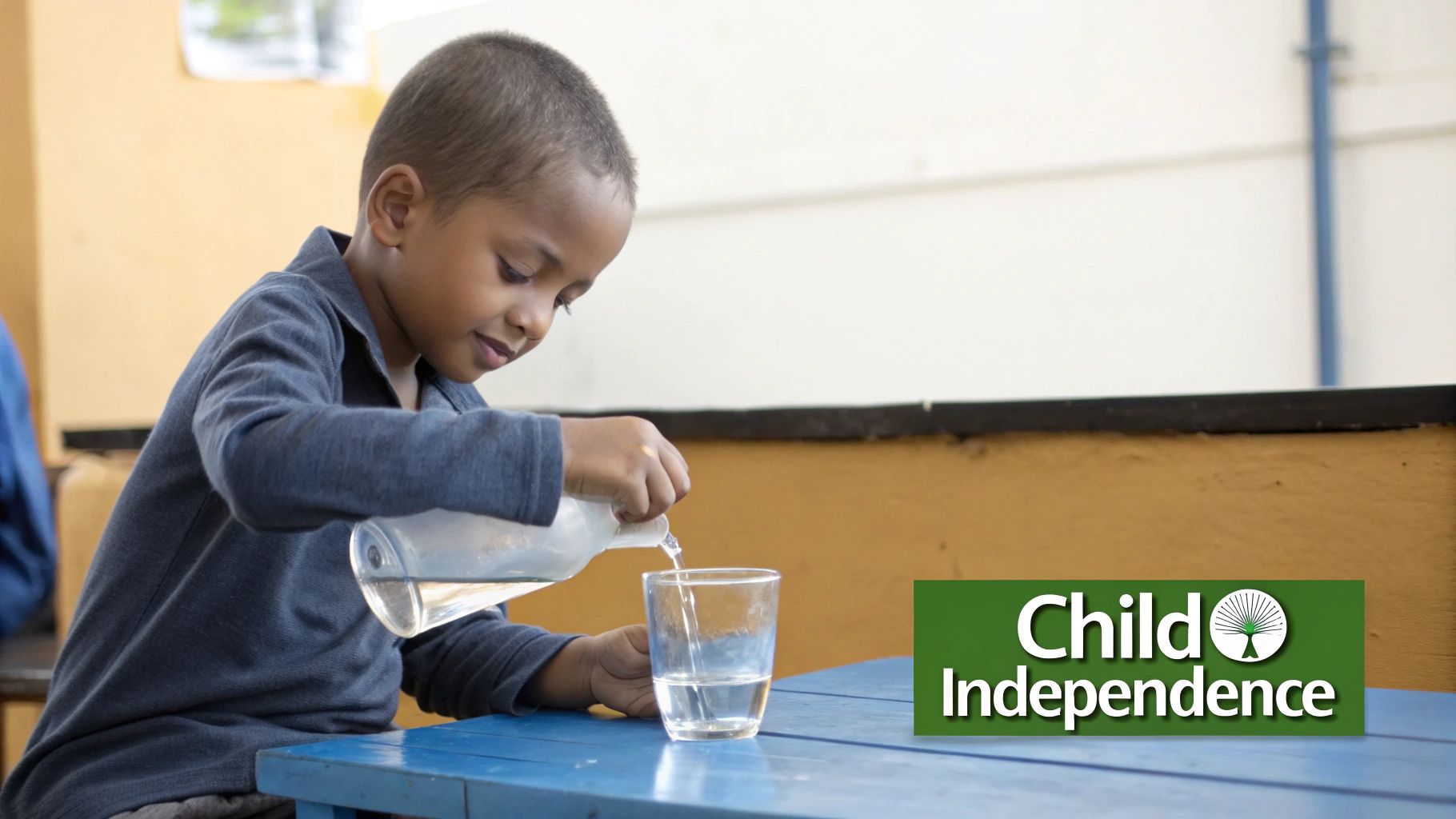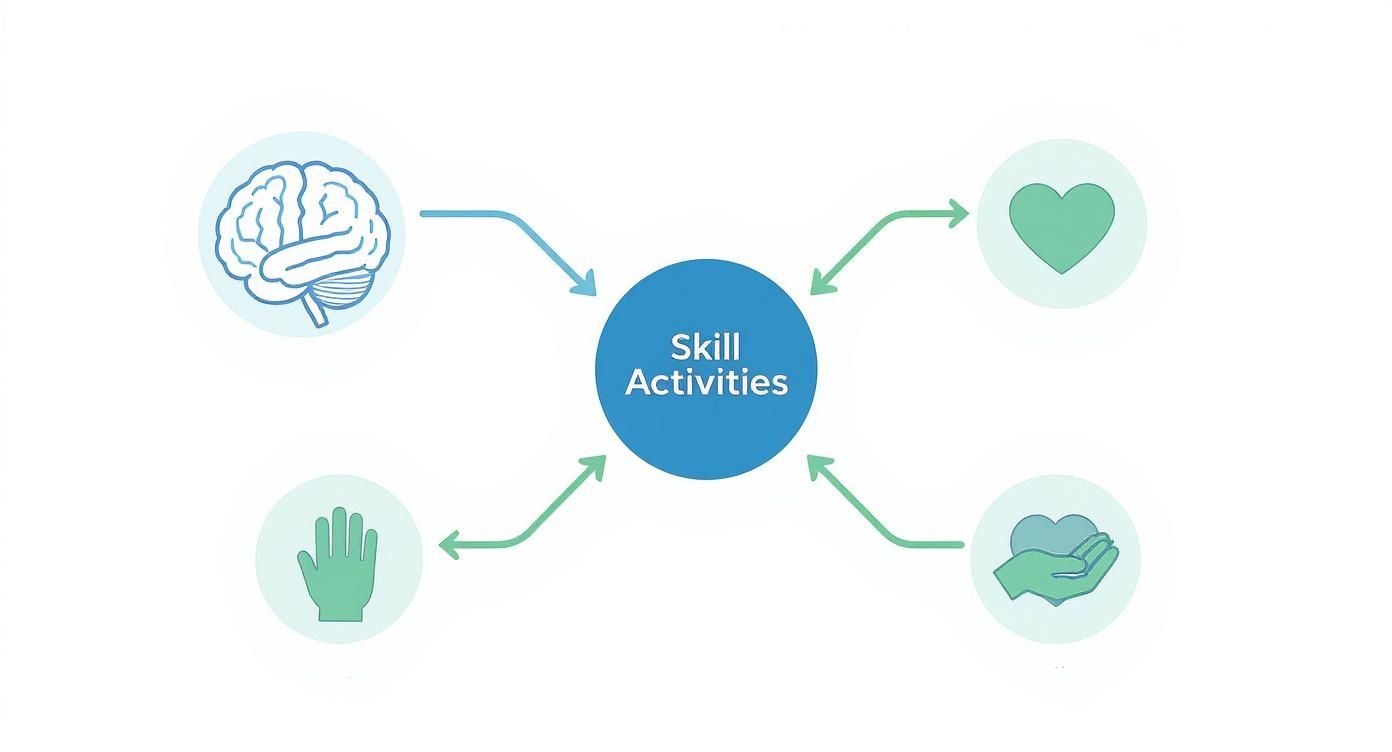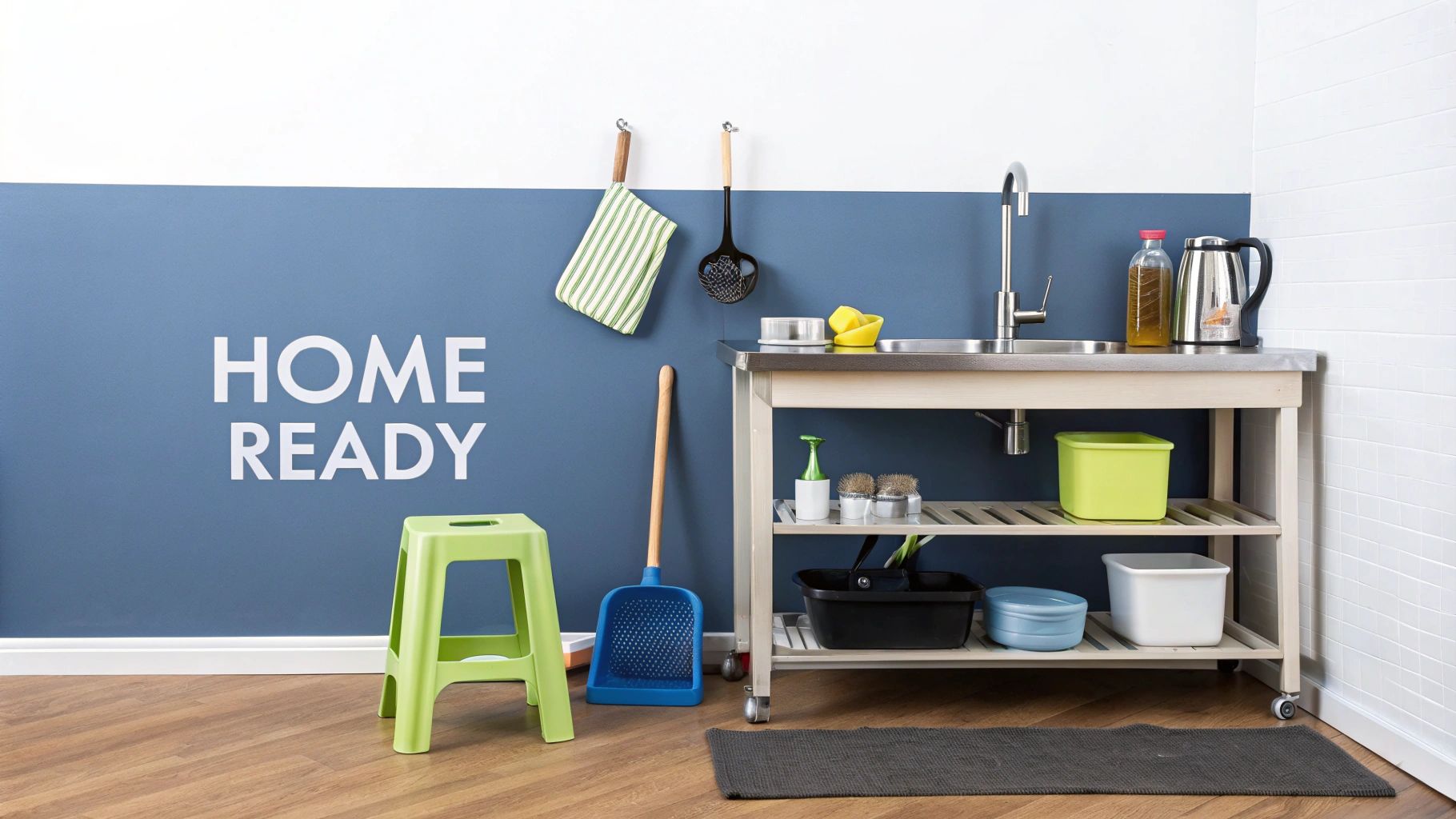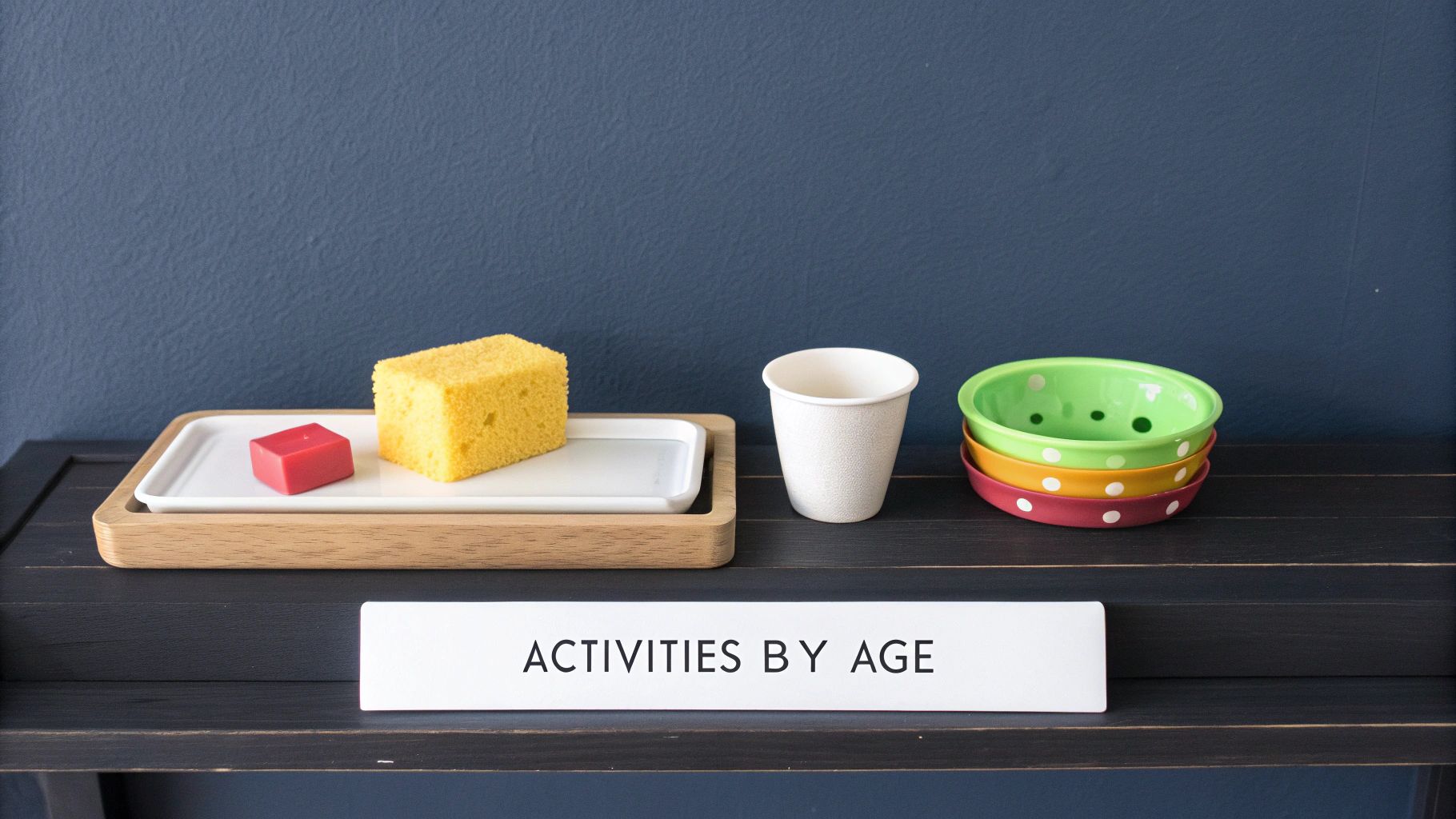
Montessori at Home: practical life activities in montessori
Share
If you've ever seen a toddler laser-focused on pouring water from one tiny pitcher to another, you’ve witnessed the magic of Montessori practical life activities. These aren't just make-believe games or chores in disguise. They are real, purposeful tasks that you see every day—like buttoning a coat, slicing a banana, or wiping up a spill.
In the Montessori world, we see these simple actions as powerful learning opportunities. They are the carefully chosen, real-world work that helps children build independence, coordination, and a deep sense of focus.
Why Practical Life Activities Are a Cornerstone of Montessori

Think about learning a new skill, like woodworking. You wouldn't start by building a bookshelf. You’d first learn to hold a hammer, measure a piece of wood, and carefully sand a surface. Each of those small, deliberate steps builds the confidence and skill needed for the bigger projects. Practical life activities in Montessori are exactly like that for a child.
These tasks are the essential building blocks for a child's entire development. They ground children in their environment, making them feel like capable and respected members of the family. When a child manages to pour their own juice without spilling or button their own jacket, it's more than just a completed task. It’s a powerful "I did it!" moment that builds genuine self-esteem.
Building a Foundation for Future Learning
That feeling of capability isn't just a nice-to-have; it's what directly paves the way for more complex academic skills later on. The focused movements and sequences in practical life are fundamental for developing:
- Concentration: Carefully spooning beans from one bowl to another isn't about moving beans. It's about training the mind to focus for extended periods.
- Coordination: Activities that require precise hand movements, like pouring or threading, refine the fine motor skills needed for learning to write.
- Order: Following the logical sequence of an activity, like setting a place at the table, builds an internal sense of order—a key concept for math and science.
- Independence: The profound feeling of, "I did it myself!" fosters self-reliance and sparks an inner drive to learn and contribute.
The big idea here is empowerment. By trusting children with real responsibilities, we show them that they are valued. We shift the dynamic from a child who is constantly cared for to a child who can care for themselves and their environment.
This whole approach has surprisingly deep roots. Dr. Maria Montessori first noticed children’s natural pull toward these tasks in her first school, the Casa dei Bambini, way back in 1907. This observation became a cornerstone of her method, designed to nurture independence from the very beginning.
If you’re feeling inspired to bring some of this into your own home, our guide on implementing Montessori education at home is a fantastic place to start.
How Practical Life Activities Build Essential Skills
Practical life activities are so much more than meets the eye. They're not just simple chores; they are thoughtfully designed experiences that really fuel a child's all-around development. Think of each activity as a workout for the brain, body, and heart, strengthening essential skills in four key areas at the same time.
These purposeful actions act as a bridge, connecting a child’s inner world with the world around them. This connection lets them build a complex web of skills—cognitive, physical, emotional, and social—right from the ground up. Let's dig into how these everyday tasks make such a huge difference.
Cognitive Growth and Logical Thinking
Sequencing is the secret sauce behind many practical life activities in Montessori. When a child sets a table, they aren't just putting things down randomly. There’s a logical order to it: first the placemat, then the plate, then the fork on the left, and the knife and spoon on the right.
This simple process is a powerhouse for building cognitive skills like executive function, problem-solving, and logical thinking. Each step has to be done in the right order to get to the finish line, teaching a child to think through a process from start to finish. This lays the groundwork for understanding more complex math and science concepts down the road.
Physical Coordination and Motor Skills
The physical benefits are probably the easiest to spot. Activities are intentionally set up to help a child move from using their big muscle groups to mastering small, precise movements. Carrying a tray with glasses on it, for example, requires gross motor skills—balance, a strong core, and careful walking.
From there, they move on to tasks that demand fine motor skills, like using tongs to move pom-poms from one bowl to another or figuring out the buttons on a dressing frame. More than just making them independent, these activities are key for building real-world competence. Tasks like pouring, spooning, and buttoning actively help children improve fine motor skills, which are crucial for things like learning to write.
The research backs this up, too. One study introduced over 50 different practical life exercises into kindergarten classrooms. After six months, the kids who participated showed significantly better fine motor control than their peers. It's a clear line connecting these activities to physical skill.
The hand is the instrument of the mind. By training their hands to perform precise, purposeful work, children are simultaneously training their brains to concentrate, solve problems, and execute complex sequences.
Emotional and Social Development
Emotionally, there's nothing quite like the feeling of mastering a task. Successfully pouring water into a glass without spilling or zipping up a jacket for the very first time builds a huge amount of self-esteem and resilience. It sends a powerful message: "I can do this." This confidence becomes the foundation for taking on new challenges without being afraid to fail.
On the social side, practical life includes specific lessons in Grace and Courtesy. These lessons teach children how to interact with others respectfully—things like how to greet someone, offer to help, or politely interrupt a conversation. By practicing these social skills in a safe, guided space, children learn empathy and figure out how to navigate their social world with kindness and confidence.
Exploring the Four Categories of Practical Life
To make sense of the vast world of practical life activities in Montessori, they’re neatly organized into four main categories. Think of it like a well-stocked toolkit. Each drawer holds different tools, but they all work together on the same project: building a capable, independent child.
This framework isn't just for show; it ensures a child's development is balanced and whole. It deliberately addresses everything from fine motor skills to social graces. Once you understand these four areas, you’ll see how simple, everyday tasks are masterfully woven together to create a rich developmental tapestry for your child.
Care of Self
The first and most foundational category is Care of Self. These are the activities that give children the power to handle their own personal needs. It's all about fostering that "I can do it myself" spirit when it comes to getting dressed, washing up, or making a simple snack.
This is where true independence begins. Gaining skills in this area builds a powerful sense of self-reliance and body awareness.
- Getting Dressed: Working with dressing frames that have buttons, zippers, and snaps.
- Personal Hygiene: Learning to properly wash hands, brush teeth, or comb hair.
- Food Preparation: Slicing a banana with a child-safe knife, spreading jam on toast, or pouring a glass of water.
Care of the Environment
Next up is Care of the Environment, which gently guides the child's focus outward. These activities teach them how to be responsible, contributing members of their home and, eventually, their community. It’s about building a connection to their surroundings and fostering a sense of ownership.
When a child waters a plant or sweeps up crumbs, they're learning a profound lesson: their actions can have a positive impact on the world around them. This nurtures a deep-seated respect for their environment and the people who share it.
The infographic below shows just how these activities support holistic development, engaging a child's mind, body, and emotions all at once.

As you can see, a single, simple activity can strengthen multiple developmental areas simultaneously, building a wonderfully well-rounded foundation for life.
Grace and Courtesy
The third category, Grace and Courtesy, is all about developing social skills. These are the direct, hands-on lessons that help children navigate social situations with poise and respect. It’s where they learn how to greet someone, say "please" and "thank you," or wait patiently for their turn.
These aren't just about old-fashioned manners; they are about empathy. Grace and Courtesy lessons give children the tools they need to build positive relationships and function harmoniously in a group.
Examples include practicing how to interrupt a conversation politely, offering to help a friend who is struggling, or carrying a chair across the room without bumping into others. These seemingly small skills are the building blocks of a compassionate and cooperative community.
Control of Movement
Finally, Control of Movement is focused on refining a child’s physical coordination. These activities help children gain mastery over their own bodies, learning to move with intention and precision. This includes both big, whole-body movements (gross motor skills) like walking carefully on a line, and small, detailed movements (fine motor skills) like transferring tiny beads with tweezers.
These exercises are absolutely crucial for developing the physical control needed for more complex tasks later on—especially the precise hand movements required for writing. For instance, an activity like spooning beans from one bowl to another might seem simple, but it’s expertly training the hand and eye to work in perfect concert.
To bring it all together, here's a quick look at how these four categories work in harmony.
Categories of Montessori Practical Life Activities
| Category | Core Purpose | Example Activities |
|---|---|---|
| Care of Self | Fostering independence and personal responsibility. | Getting dressed, washing hands, preparing a simple snack. |
| Care of the Environment | Developing a sense of stewardship and respect for one's surroundings. | Watering plants, wiping a table, sweeping the floor. |
| Grace and Courtesy | Building social skills, empathy, and respectful interaction. | Greeting others, saying "please" and "thank you," waiting your turn. |
| Control of Movement | Refining fine and gross motor skills and physical coordination. | Walking on a line, pouring water, transferring objects with tongs. |
Each category serves a unique purpose, but they all overlap to support the development of a confident, capable, and well-adjusted child.
Creating a Practical Life Friendly Home

Turning your home into a space that encourages independence doesn’t mean you need a massive renovation or a big budget. The real heart of practical life activities in Montessori is simply about weaving your child into the real, everyday work of the household. Think of it like setting up a well-organized professional kitchen—everything has its place, and it’s all within reach.
The idea is to create a home environment built on accessibility and order. When children can easily access what they need, it empowers them to jump in and take initiative. A few thoughtful tweaks can make a huge difference, helping them feel like capable, contributing members of the family. This isn't just about convenience; it's about building genuine confidence by letting them master their own world.
Making Everyday Spaces Accessible
Try this: get down on your child’s level and look at your home from their perspective. What’s just out of reach? What tools are too big and clunky for their small hands to manage? The kitchen is usually the best place to start making a few simple, high-impact changes.
- Set Up a "Help Yourself" Station: Find a low shelf or a bottom drawer in the kitchen that can be theirs. Stock it with child-sized plates, bowls, cups, and utensils so they can set their own spot at the table or grab a snack plate.
- Give Them a Boost: A sturdy step stool or a dedicated learning tower can be a total game-changer. It gives them safe access to the sink for washing hands or rinsing vegetables. We have a whole guide on the benefits of a learning tower kitchen helper and how it can completely transform your kitchen dynamic.
- Organize Kid-Friendly Cleaning Supplies: Keep a small dustpan and brush, a handheld broom, or a few small cloths tucked away in an accessible spot. The next time a spill happens, they’ll know exactly where to find the tools to take care of it themselves.
The goal isn't just to keep children occupied, but to give them real, meaningful work. By preparing their environment, we send a powerful message: "You are a capable member of this family, and your contributions are valued."
Fostering Independence Beyond the Kitchen
This philosophy of accessibility can easily extend throughout your entire home. By the front door, you could add a low hook for their jacket and a small basket for their shoes. In the bathroom, a step stool at the sink and a low-hanging towel empower them to handle their own hand-washing and tooth-brushing.
A great way to integrate these responsibilities into a routine is by exploring some chore chart ideas for kids, which can really help foster that sense of independence.
This isn't just a niche idea; it's a globally adaptable approach. Montessori schools all over the world tailor these practical life exercises to fit their own cultural contexts, which really shows you the universal power of this method. In fact, one study highlighted just how much these activities contribute to a child's all-around development, proving that fostering independence is a universal key to learning.
Matching Activities to Your Child's Age

One of the most powerful things about Montessori practical life activities is how they grow right alongside your child. The trick is to find that sweet spot—an activity that's challenging enough to keep them hooked but not so hard it leads to a meltdown. Meeting your child exactly where they are is the secret to building real confidence and a genuine desire to help out.
Think about it like learning to read. You wouldn't hand a toddler a novel; you start with picture books. It's the same idea with practical life. We introduce skills in a logical order, letting each new ability build on the last. This way, every new task feels less like a chore and more like an exciting step toward independence.
Toddlers (Around 1-3 Years)
For toddlers, the world is one big, fascinating place to explore. Their "work" right now is all about mastering big body movements, getting a better handle on their grasp, and figuring out simple, one- or two-step jobs. The best activities are short, have an obvious point, and give them a great shot at success.
The focus here is really on those foundational movements and the first steps of self-care. It's about setting them up for those first, proud "I did it!" moments.
- Wiping a small spill: Keep a small sponge in a spot they can reach. When a little water spills, you can calmly show them how to wipe it up. This is a brilliant, low-stakes way to teach cause and effect.
- Putting toys in a basket: This couldn't be simpler, but it reinforces the idea of order. Having a clear beginning and end helps a toddler's budding concentration.
- Pouring dry goods: Start with something easy to clean up, like big pasta shells or pom-poms, and two small pitchers. This builds the exact skills they'll need later for pouring water or milk.
- Pulling up their own pants: Don't underestimate this one! This simple act of dressing gives them a huge sense of pride and body awareness.
The toddler stage is all about introducing the idea of helping. We're aiming for participation, not perfection. Every little attempt is a giant leap for them.
Preschoolers (Around 3-5 Years)
Once they hit the preschool years, their fine motor skills and attention spans really take off. This means their practical life activities can get a bit more complex. They can follow a few steps in a row and handle tasks that require more precision and care. This is the age when they can start making real, meaningful contributions around the house.
You’ll see a shift from simple, one-off actions to activities that complete a whole cycle of work. This is a great time to set up a dedicated workspace, like their own little table. If you need some inspiration, our guide on choosing the right Montessori activity table can help you create the perfect spot for these new adventures.
- Preparing a simple snack: Slicing a banana with a kid-safe knife, spreading jam on toast, or peeling a clementine are all fantastic and empowering tasks.
- Setting the table: This is a surprisingly complex job! It involves sequencing (placemat, then plate), one-to-one correspondence (one fork per person), and spatial awareness.
- Folding laundry: Start them off with easy wins, like washcloths or small hand towels. This helps with fine motor control and brings a sense of order to a chaotic basket.
- Watering plants: Using a small watering can is a great way to teach them how to care for another living thing. It also takes a surprising amount of motor control to not flood the pot!
Early Elementary (Around 6+ Years)
By this age, kids are ready for bigger responsibilities that involve planning and more advanced skills. They can finally understand the "why" behind their chores and really take ownership of their role in the family.
The activities can now involve multiple steps and require a higher level of trust from you. This is a wonderful time to introduce skills that will serve them for a lifetime, reinforcing their sense of competence and value within the family.
- Packing their own lunch: With a little guidance, they can choose from pre-approved options, put together a sandwich, and pack their own lunchbox.
- Basic hand sewing: Learning to sew a button onto a scrap of fabric is a fantastic activity for developing patience, precision, and serious fine motor control.
- Helping with meal prep: Kids this age can be genuinely helpful in the kitchen. They can wash vegetables, measure out ingredients, or stir a mixture.
- Caring for a pet: Taking on the daily job of feeding a fish or brushing the cat teaches empathy, consistency, and what it means to be responsible for another creature.
Common Questions About Practical Life Activities
Jumping into practical life activities in Montessori can feel both thrilling and a bit daunting. As you start bringing these ideas into your daily routine, you're bound to have some questions. We've gathered some of the most common ones parents ask to help you feel more confident as you guide your child toward independence.
Think of this as your go-to guide for troubleshooting. The goal isn't to get everything perfect right away. It's about creating a warm, supportive space where your child feels safe to try new things, make mistakes, and learn along the way.
Do I Need to Buy Expensive Montessori Materials?
This is probably the biggest myth out there—that you need a shopping cart full of expensive, specialized equipment. The simple answer is no, you absolutely don't.
The real heart of practical life is using real, everyday things you already have at home. The trick is to find items that are child-sized and actually work—a small pitcher for pouring, a little broom for sweeping, or a real sponge for wiping up spills. You're trying to genuinely include your child in the work of the home, not just collect a set of branded materials. Your real investment here is your time and attention, not pricey gear.
What If My Child Makes a Huge Mess?
Let's be clear: messes are going to happen. In fact, they're a critical part of the learning process. In the Montessori world, spills and mistakes aren't failures; they're valuable teaching moments. The most important thing is how you react.
A mess is simply a problem to be solved. By staying calm and guiding your child through the cleanup process, you teach them resilience, responsibility, and the important lesson that mistakes are manageable.
Keep child-sized cleaning supplies handy and accessible—a small towel, a spray bottle with water, or a mini dustpan. When a spill happens, the best response is a calm, "Oops! That's okay, let's get the sponge and clean it up together." This simple shift in language reframes the whole experience from a negative accident into a chance to practice a new skill. The focus should always be on the process, not on a flawless outcome.
How Do I Introduce a New Activity?
How you show a new task to your child is just as important as what the task is. The Montessori way of presenting an activity is really intentional—it's designed to capture your child's full attention and set them up for success from the get-go.
Here’s the basic idea:
- Set the Stage: Pick a calm, quiet moment when there aren't a lot of distractions.
- Show, Don't Tell: Demonstrate the entire activity from start to finish. Use slow, deliberate, and precise movements. The key here is to use very few, if any, words. This allows your child to focus completely on your actions without trying to process verbal instructions at the same time.
- Invite Them to Try: Once you’re done, simply ask, “Would you like a turn?” If they say no, that’s totally fine. Don't push it. Just put the activity away and you can offer it again another day.
This slow, silent demonstration is incredibly respectful of a child's ability to learn through pure observation. It's an invitation to learn, not a demand to perform.
At Ocodile, we believe in creating spaces where children can safely explore their independence. Our thoughtfully designed furniture helps you build a home that supports your child’s natural desire to learn and contribute. Discover our collection of child-friendly furniture at Ocodile.com.








